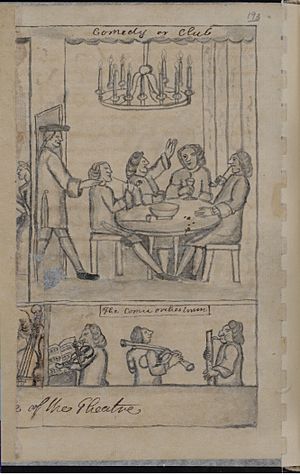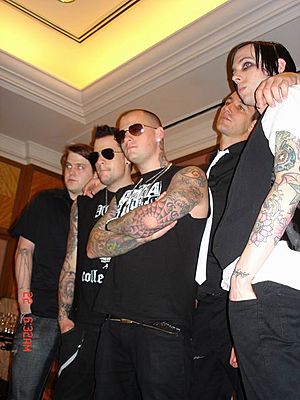Music of Annapolis facts for kids
The music of Annapolis, Maryland has been very important in the music history of the United States during the colonial era. Over time, Annapolis has also created many famous music groups and organizations.
Contents
How Did Music Start in Annapolis?
In the 1700s, special singing schools started to appear in the American colonies. These schools began in New England and reached Maryland by 1764, starting in Annapolis. People would meet in the evenings to learn about music.
A singing master (or music teacher) would lead these classes. They taught both young people and adults how to read music notes and sing in parts. They also taught Christian hymns. Most of these teachers learned music in other singing schools, not from formal music colleges. Many were traveling teachers who moved from town to town.
Annapolis was the first town in Maryland to have a singing school. The first one opened at St. Anne's Anglican Church in 1764. Phillip Williams was the teacher, and he taught people to sing psalmody (hymns) in four parts. Williams only stayed for one year, but Hugh Maguire replaced him the next year.
After the Revolutionary War, singing schools became less common in Maryland, including Annapolis. Alexander Gray was one of the last known singing masters in Annapolis around 1786.
The Tuesday Club: A Musical Group from the Past
During the colonial period, Annapolis was a large city in North America. It was home to a group called the Tuesday Club. This club kept very detailed records of music in the city, more than any other group at the time.
The club started in 1745. It was founded by Alexander Hamilton, who copied similar clubs he had seen in Edinburgh, Scotland. At first, music was not the main focus of the group. However, it soon became a big part of their biweekly meetings, called sederunts.
The Tuesday Club performed both original songs and published music. Their music included Scottish and English folk songs, and English theater pieces. Some members were Jonas Green, who printed the Maryland Gazette and music books, and Thomas Bacon, a famous composer in the club. His music sounded very European.
The music of the Tuesday Club was made to sound like European classical music. The members wanted to be like the famous composers of Western classical music. However, their performances were mostly for fun, not for serious art. The music they wrote was casual and probably not meant for people outside the club to hear. This music is some of the earliest non-religious music known from America. They used instruments like the French horn, flute, cello, viola, and harpsichord.
Popular Music in Annapolis
Annapolis has been a home for many popular music groups. In the 1980s, two important early emo bands, Moss Icon and The Hated, were from Annapolis. They recorded music for a local record label called Vermin Scum.
Vermin Scum also released music by other bands like Black Dice and Universal Order of Armageddon. Annapolis has also been home to the funk rock band Jimmie's Chicken Shack, SHAED (which used to be called The Walking Sticks), and the band Good Charlotte.
Important Music Organizations
The United States Naval Academy Band is the oldest active-duty military band in the country. It was officially founded in 1852. However, music has been a part of the Naval Academy since it first opened. Early musicians included drummers and fifers who played calls like tattoo (lights out) and reveille (wake up).
When the Band was officially funded in 1852, bandmaster John Philip Pfeiffer chose the first musicians. They played their first concert in 1853 for the Secretary of the Navy. During the Civil War, the Band's musicians were sent to other places. The Academy moved temporarily to Newport, Rhode Island, and the Band returned in 1865.
After the war, band members became civilian employees of the Academy. This meant their pay went down. To make up the difference, midshipmen (students) and officers paid a monthly fee. Soon after, Superintendent David Dixon Porter improved the Band. He made it bigger and gave them nice uniforms.

In the 1880s, woodwind instruments were added to the Band. Before this, it only had brass instruments. New instruments included clarinets, oboes, and piccolos. The youngest bandmaster in the Band's history, Charles Adams Zimmerman, took over in 1887. He started a theater group and became very popular with the cadets.
In 1894, the Naval Academy Band started wearing the same uniform as the United States Marine Band. Zimmerman stayed as bandmaster even when he was offered a more important job in 1897. He is best known for writing "Anchors Aweigh" in 1907. He wanted it to be an inspiring and timeless song for football games.
Under the next director, Adolph Torovsky, the Academy Band made its first recording in 1920. They recorded Zimmerman's "Anchors Aweigh" and one of Torovsky's own songs. In 1939, the Band started playing on Maryland radio stations. The director, Lieutenant Sima, wrote the "Victory March", another famous song from the Academy.
In the mid-20th century, under Alexander Cecil Morris, the Academy Band performed on television for the first time. They also started a weekly radio show and got new instruments and facilities. In the 1970s, bandmaster Ned E. Muffley welcomed women into the Naval Academy's music program. The Academy's first rock band, Tidal Wave, also became somewhat famous.
His successor, William J. Phillips, created amazing performances with mostly new music. These changes attracted new audiences, and the Academy Band became known around the world. In 1973, Gayle Slayter joined the Band. She became known as the "Naval Academy's First Lady of Song" during her twenty-year career.
The Naval Academy Band also has other smaller groups, like a brass quintet, a wind quintet, and a marching band.
The Naval Academy Music Department has had only four civilian music directors in over a hundred years. J.W. Crosley wrote the music for Navy Blue and Gold, the Naval Academy's alma mater, in 1923. Donald C. Gilley followed him in 1943 and started the very popular yearly performance of Handel’s Messiah.
In 1972, Dr. John Barry Talley became the Director of Musical Activities. He held this job until he retired in 2006. Under Dr. Talley, the Academy's music program became famous worldwide. Dr. Aaron Smith took over after Dr. Talley.
The United States Naval Academy Department of Musical Activities has over one thousand midshipmen (students) who join many different music groups. These include Men’s and Women’s Glee Clubs, three Chapel Choirs, the Drum and Bugle Corps, Pipes and Drums, a Symphony Orchestra, and a music theater program.
Many of these groups travel a lot, performing in major concert halls across America and in other countries. They have been on TV shows like “The Today Show” and “Good Morning America.” The Naval Academy also has a Distinguished Artists Series. This series brings world-class performers to play for the midshipmen and the public.
Some of the most popular events in Annapolis are the yearly Halloween Organ Concert, the Christmas Messiah program, and the spring Glee Club musical. These events often have over 4,000 people in the audience. The Naval Academy Chapel Organ is one of the most important organs in the country. Monte Maxwell is the main chapel organist.
Annapolis Chorale
The Annapolis Chorale is a non-profit group that includes a Chamber Chorus, Chamber Orchestra, and the Annapolis Youth Chorus. They perform both classical and semi-classical music. They also have educational programs and scholarships.
The Chorale was started in 1974 by James A. Dale. From 1976 to 1978, Mark Tardue helped the Chorale grow. He organized a sold-out concert in 1977 that became very famous and helped the Chorale's reputation. J. Ernest Green became the music director and conductor in 1984. He is the longest-serving person in that position in the group's history.
Annapolis Symphony Orchestra
The Annapolis Symphony Orchestra started in 1962. It is a well-known group that has hosted famous musicians like Cuban violinist Guillermo Perch and Charlie Byrd. The Annapolis Orchestra even inspired composer David Ott to write the Annapolis Overture, which was first performed in 1995.
The Sons of the Severn
The Sons of the Severn is a non-profit men's singing group. It was founded in Annapolis in 1949. This chorus represents the Anne Arundel County, MD Chapter of the Barbershop Harmony Society. In 2010, they won the Western Division Chorus Championship in their district.
The Sons of the Severn chorus performs all year in Annapolis, Anne Arundel County, and nearby areas. They have performed at places like the Maryland Statehouse, Oriole Park at Camden Yards, and Annapolis City Hall. T. J. Barranger has been the group's director since 2005. He has led the chorus to six straight appearances in the district finals. The Sons of the Severn chorus also helps charities in Anne Arundel County, MD, like the North County Emergency Outreach Network, and supports music education in high schools.
Other Music Organizations
Annapolis is also home to the Annapolis Opera and the Ballet Theatre of Maryland. The Annapolis Opera started in 1972. It offers music programs and contests all year. The Annapolis Maritime Museum supports the Chesapeake Music Institute. This group helps promote traditional music from the Chesapeake Bay area.
Music Venues and Festivals
In modern Annapolis, there are several notable music venues. The King of France Tavern and the Ebb Tide are known for blues and jazz music. The Maryland Hall for the Creative Arts is another major local venue. It hosts many famous performing groups throughout the year and was founded in 1979.
On November 1, 1997, Rams Head On Stage held its first concert with Livingston Taylor. Since then, the venue has hosted nearly 8,000 shows. In 27 years, Rams Head has entertained over 1.5 million concert-goers. It continues to bring national entertainers to Annapolis, hosting more than 400 shows a year. In 2012, Pollstar Magazine named Rams Head On Stage the Top Club Under 500 Seats in the World. Rams Head also put on the Silopanna Music Festival in 2014, featuring artists like The Flaming Lips and Dashboard Confessional.
The Annapolis Music Fest first took place in June 2002. This festival features both touring and local bands playing different styles of rock and hip hop.
Eastport-A-Rockin' is another Annapolis music festival. It was founded in 1997 by James Borchelt. This festival features local and national artists on four stages. It is usually held on the last weekend of June at the Annapolis Maritime Museum. It is the longest-running music festival in the city. Past performers include Good Charlotte, Jimmie's Chicken Shack, and SHAED.



